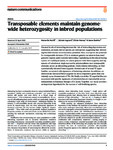Transposable elements maintain genome-wide heterozygosity in inbred populations
| dc.contributor.author | De Kort, H | |
| dc.contributor.author | Legrand, S | |
| dc.contributor.author | Honnay, O | |
| dc.contributor.author | Buckley, J | |
| dc.date.accessioned | 2023-01-18T10:04:11Z | |
| dc.date.issued | 2022-11-17 | |
| dc.identifier.issn | 2041-1723 | |
| dc.identifier.issn | 2041-1723 | |
| dc.identifier.other | 7022 | |
| dc.identifier.uri | http://hdl.handle.net/10026.1/20185 | |
| dc.description.abstract |
Elevated levels of inbreeding increase the risk of inbreeding depression and extinction, yet many inbred species are widespread, suggesting that inbreeding has little impact on evolutionary potential. Here, we explore the potential for transposable elements (TEs) to maintain genetic variation in functional genomic regions under extreme inbreeding. Capitalizing on the mixed mating system of Arabidopsis lyrata, we assess genome-wide heterozygosity and signatures of selection at single nucleotide polymorphisms near transposable elements across an inbreeding gradient. Under intense inbreeding, we find systematically elevated heterozygosity downstream of several TE superfamilies, associated with signatures of balancing selection. In addition, we demonstrate increased heterozygosity in stress-responsive genes that consistently occur downstream of TEs. We finally reveal that TE superfamilies are associated with specific signatures of selection that are reproducible across independent evolutionary lineages of A. lyrata. Together, our study provides an important hypothesis for the success of self-fertilizing species. | |
| dc.format.extent | 7022- | |
| dc.format.medium | Electronic | |
| dc.language | en | |
| dc.language.iso | eng | |
| dc.publisher | Springer Science and Business Media LLC | |
| dc.subject | DNA Transposable Elements | |
| dc.subject | Inbreeding | |
| dc.subject | Arabidopsis | |
| dc.subject | Heterozygote | |
| dc.subject | Genomics | |
| dc.title | Transposable elements maintain genome-wide heterozygosity in inbred populations | |
| dc.type | journal-article | |
| dc.type | Article | |
| plymouth.author-url | https://www.ncbi.nlm.nih.gov/pubmed/36396660 | |
| plymouth.issue | 1 | |
| plymouth.volume | 13 | |
| plymouth.publisher-url | http://dx.doi.org/10.1038/s41467-022-34795-4 | |
| plymouth.publication-status | Published online | |
| plymouth.journal | Nature Communications | |
| dc.identifier.doi | 10.1038/s41467-022-34795-4 | |
| plymouth.organisational-group | /Plymouth | |
| plymouth.organisational-group | /Plymouth/Faculty of Science and Engineering | |
| plymouth.organisational-group | /Plymouth/Faculty of Science and Engineering/School of Biological and Marine Sciences | |
| plymouth.organisational-group | /Plymouth/REF 2021 Researchers by UoA | |
| plymouth.organisational-group | /Plymouth/REF 2021 Researchers by UoA/UoA06 Agriculture, Veterinary and Food Science | |
| plymouth.organisational-group | /Plymouth/REF 2021 Researchers by UoA/UoA06 Agriculture, Veterinary and Food Science/UoA06 Agriculture, Veterinary and Food Science MANUAL | |
| plymouth.organisational-group | /Plymouth/Users by role | |
| plymouth.organisational-group | /Plymouth/Users by role/Academics | |
| dc.publisher.place | England | |
| dcterms.dateAccepted | 2022-11-08 | |
| dc.rights.embargodate | 2023-1-20 | |
| dc.identifier.eissn | 2041-1723 | |
| rioxxterms.versionofrecord | 10.1038/s41467-022-34795-4 | |
| rioxxterms.licenseref.uri | http://www.rioxx.net/licenses/all-rights-reserved | |
| rioxxterms.licenseref.startdate | 2022-11-17 | |
| rioxxterms.type | Journal Article/Review |


